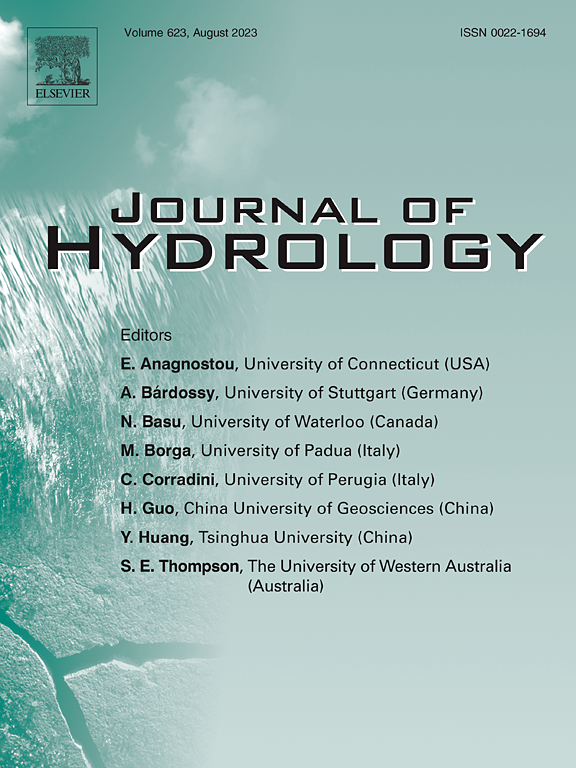不同水文气象条件下青藏高原郭琼岗日冰川流域悬沙源动态
IF 5.9
1区 地球科学
Q1 ENGINEERING, CIVIL
引用次数: 0
摘要
冰川盆地悬浮泥沙源(SSS)的动力学是理解全球变化背景下陆地表面过程的关键,也是冰冻圈水文和输沙研究领域的挑战。本研究采用SSS指纹技术,定量分析了青藏高原南部郭邛岗日冰川盆地SSS受冰川融化、融雪和降雨影响的变化。此外,该研究还提出了一种通过水文建模验证SSS估计结果的方法策略。研究结果表明,不同来源的泥沙贡献有很大差异,这与径流组分的动态有关。冰川带占总面积的14.8%,占沉积物总量的52.8%,侵蚀强度高。极高海拔裸地(>5400 m)、高海拔裸地(4800 ~ 5400 m)和草甸区分别占51.7%、18.8%和14.7%,平均占19.7%、21.0%和6.5%。在冰川融化事件中,冰川是沉积物的主要SSS(70.8%),冰川融化是径流的主要SSS(85.8%)。在融雪期间,冰川和极高海拔裸地区是主要的SSS区,分别贡献了53.5%和22.5%的沉积物。融雪侵蚀在径流中所占的比例最大,为70.7%,表明融雪侵蚀主要发生在海拔5400 m以上的裸地。在降雨过程中,冰川、极高海拔裸地和高海拔裸地是主要的SSS区,分别贡献了34.2%、23.8%和36.4%的泥沙。降雨在径流中所占比重最大,为64.9%,表明降雨侵蚀主要发生在海拔4800 m以上的裸地。本研究初步揭示了不同水文气象条件下冰川流域SSS的动态特征。研究结果可协助管理当局在高寒地区有效实施水土保持措施。本文章由计算机程序翻译,如有差异,请以英文原文为准。
Dynamics of suspended sediment sources in the Kuoqionggangri glacier Basin, Tibetan Plateau, under diverse hydrometeorological conditions
The dynamics of suspended sediment sources (SSS) in glacial basins are critical for understanding land surface processes in the context of global change, and present challenges in the fields of cryospheric hydrology and sediment transport research. This study employed SSS fingerprinting techniques to quantify and analyze variations in SSS influenced by glacier melt, snowmelt, and rainfall in the Kuoqionggangri Glacier Basin, located in the southern Tibetan Plateau. Furthermore, the study proposes a methodological strategy for validating SSS estimation results through hydrological modeling. The findings indicate substantial variation in sediment contributions from different sources, which correlate with the dynamics of runoff components. The glacier zone, which constitutes 14.8 % of the area, contributed 52.8 % of sediments, highlighting its high erosion intensity. The extremely high-altitude bare land (>5400 m), high-altitude bare land (4800 ∼ 5400 m), and meadow zones, comprising 51.7 %, 18.8 %, and 14.7 % of the area, respectively, contributed 19.7 %, 21.0 %, and 6.5 % of the sediments on average. During glacier melt events, the glacier serves as the predominant SSS (70.8 %) of the sediment, with glacier melt dominating the runoff at 85.8 %. During snowmelt events, the glacier and extremely high-altitude bare land zones were the main SSS areas, contributing 53.5 % and 22.5 % of the sediment, respectively. With snowmelt comprising the greatest proportion of runoff at 70.7 %, it is suggested that snowmelt-induced erosion predominantly occurs in bare land with altitudes above 5400 m. During rainfall events, the glacier, extremely high-altitude bare land and high-altitude bare land zones were the primary SSS areas, contributing 34.2 %, 23.8 %, and 36.4 % of the sediment, respectively. With rainfall accounting for the largest share of runoff at 64.9 %, it is indicated that rainfall-induced erosion mainly occurs in bare land with altitudes above 4800 m. This study provides initial insights into the dynamic characteristics of SSS in a glacier basin under different hydrometeorological conditions. The findings can assist management authorities in the effective implementation of soil and water conservation measures in alpine regions.
求助全文
通过发布文献求助,成功后即可免费获取论文全文。
去求助
来源期刊

Journal of Hydrology
地学-地球科学综合
CiteScore
11.00
自引率
12.50%
发文量
1309
审稿时长
7.5 months
期刊介绍:
The Journal of Hydrology publishes original research papers and comprehensive reviews in all the subfields of the hydrological sciences including water based management and policy issues that impact on economics and society. These comprise, but are not limited to the physical, chemical, biogeochemical, stochastic and systems aspects of surface and groundwater hydrology, hydrometeorology and hydrogeology. Relevant topics incorporating the insights and methodologies of disciplines such as climatology, water resource systems, hydraulics, agrohydrology, geomorphology, soil science, instrumentation and remote sensing, civil and environmental engineering are included. Social science perspectives on hydrological problems such as resource and ecological economics, environmental sociology, psychology and behavioural science, management and policy analysis are also invited. Multi-and interdisciplinary analyses of hydrological problems are within scope. The science published in the Journal of Hydrology is relevant to catchment scales rather than exclusively to a local scale or site.
 求助内容:
求助内容: 应助结果提醒方式:
应助结果提醒方式:


